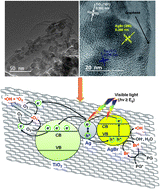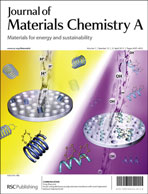A novel photocatalytic nanocomposite, Ag–AgBr/TiO2 supported on reduced graphene oxide (Ag–AgBr/TiO2/RGO), was synthesized via a facile solvothermal–photoreduction method using titanium butoxide, cetyltrimethylammonium bromide (CTAB), AgNO3 and graphene oxide (GO), during which the crystallization of TiO2, Ag nanoparticles generation from AgBr decomposition and reduction of GO to RGO were achieved simultaneously. Compared to the single-component (TiO2), two-component (Ag–AgBr, Ag/TiO2 and TiO2/RGO) and three-component (Ag–AgBr/RGO, Ag–AgBr/TiO2 and Ag/TiO2/RGO) nanocomposites, the four-component nanocomposite (Ag–AgBr/TiO2/RGO) exhibited a much higher photocatalytic activity for the degradation of penicillin G (PG) under white light-emitting diode (LED-W) irradiation. This could be attributed to the multiplex phenomena such as the surface plasmon resonance (SPR) effect of Ag nanoparticles, enhanced utilization of visible light assisted by AgBr, efficient electron transfer in the AgBr–Ag–TiO2 nanojunctions and interfacial electron transfer in the RGO sheets. Ag–AgBr/TiO2/RGO could be photoexcited by visible light with wavelengths extending up to ca. 600 nm. In addition, Ag–AgBr/TiO2/RGO possessed good photochemical stability and reusability. The mechanisms for photocatalytic activity and photochemical stability associated with Ag–AgBr/TiO2/RGO are proposed. The degradation of PG in the presence of scavengers for various reactive oxygen species (ROSs) revealed that ˙O2− significantly contributed to the degradation of PG.

You have access to this article
 Please wait while we load your content...
Something went wrong. Try again?
Please wait while we load your content...
Something went wrong. Try again?


 Please wait while we load your content...
Please wait while we load your content...